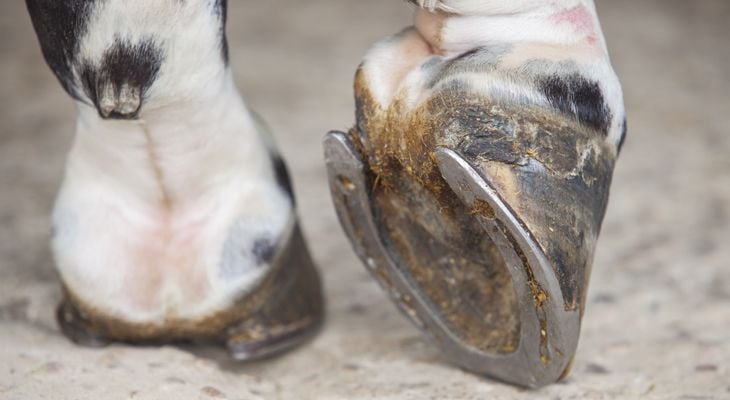
Horse hooves are complex structures that tell you a lot about your horse’s health and wellbeing. They’re also susceptible to many problems. Here are a few hoof basics as well as some of the major hoof issues your horse faces.
Anatomy
If you look at the bottom of a horse’s hoof, you’ll see two bars around a rubbery wedge that’s the shape of a pie slice. This wedge is called the frog. The outer edges of the hoof are called the walls, and they’re similar to a human’s toenails. The thin line that runs between the bars and the walls is called the white line (lamina).
People often reference the frog, toe region, quarters and heels. Imagine a clock face. The frog points to the front of the foot, or high noon. The toe region covers the space from 11 o’ clock to 1 o’ clock. Quarters cover approximately 8 o’ clock to 10 o’ clock on one side of the hoof and 2 o’ clock to 4 o’ clock on the other. The heels are at the back of the hoof, at 5 o’ clock to 7 o’ clock.
Balance
Before attempting hoof trimming, one should determine hoof balance. Professionals do this a variety of ways, including making a visual assessment before even touching a hoof. The hoof pro will look at the hoof both straight on and in profile. Every horse is different, so what looks right for one might not be right for another. Many hooves will never be symmetrical. As you work with a horse over time, you’ll find out what the balance for that particular horse is.
Canker
Canker is most common in the southeast region of the United States, but has been found all over the country. These smelly bacteria are similar to foot rot in sheep, and cause overproduction of keratin in the hoof’s horn-producing tissues. The owner might notice spongy gray or white matter on the hoof and, in extreme case, heat emanating from the hoof. Canker seems to be more common in stalled, inactive horses.
Thrush
If the frog of your horse’s hoof smells foul and oozes dark matter, your horse probably has thrush. Usually, prolonged standing in dirty conditions, such as in manure or mud, causes this bacterial condition. If you catch thrush in its early stages, an over-the-counter remedy may be a sufficient cure. However, in later stages, thrush causes severe hoof damage and lameness. To prevent thrush, consider bedding with absorbent shavings rather than straw.
Cracks
What starts out as a superficial crack in a hoof can worsen, endangering the hood’s sensitive structure. Sometimes, abscesses in the hoof cause cracks. Whatever the cause, if you notice any crack in your horse’s hoof, consult your farrier. Appropriate shoeing often prevents superficial cracks from worsening.
Footing
Think carefully about the footing your horse stands or walks on. Standing in mud for long periods can suction off shoes or promote thrush. Make sure the footing is appropriate to your horse’s activities. For example, jumpers need a surface with some give. Cutting horses need deep, forgiving footing for sudden stops and sharp turns. Consider your horse’s activities and talk to your equine veterinarian about the best footing.
Lameness
Lameness means that a horse is moving abnormally due to pain or decreased range of motion. Many things can cause lameness, including stone bruises, arthritis, tumors, overloading and diseases. Equine veterinarians may use a grading scale of 0 to 5 to pinpoint the degree of lameness, or refer to lameness as chronic or acute.
Laminitis
Lamellae are disc-like structures that form the white line on a horse’s hoof. Laminitis is the name for inflammation of the lamellae. If you look at the sole of your horse’s hoof, you can see how tightly the lamellae hold the coffin bone inside the hoof capsule. A narrow, tight line indicates a strong connection. However, if the line is stretched out, your horse might have laminitis. This serious condition requires equine veterinary treatment.
Farrier Issues
Farriers provide crucial contributions to your horse’s health. However, some horse owners worry about infection spreading through farrier tools. Farriers and horse owners share responsibility for preventing the spread of disease. Farms should quarantine newly arrived horses for a reasonable observation period. Farriers should practice good sanitation techniques, including sterilizing tools in the forge and cleaning clothing, aprons and hoof stands with an antibacterial solution.
There’s a lot to think about for optimal hoof health. If you notice any problems with your horse’s hooves, call our office today. Many hoof conditions are easy to solve if caught early, but can seriously endanger your horse’s health if left untreated.